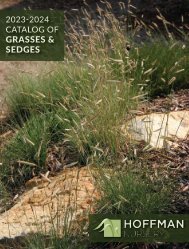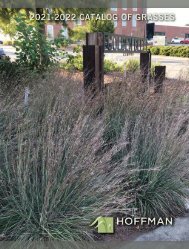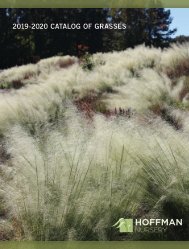2022-2023 Hoffman Nursery Catalog of Grasses & Sedges
You also want an ePaper? Increase the reach of your titles
YUMPU automatically turns print PDFs into web optimized ePapers that Google loves.
COVERING GROUND<br />
We think about covering ground literally—planting over bare soil—and in the broader sense <strong>of</strong> making<br />
our landscapes more ecologically sound. A few bare patches in the garden help support wildlife, but too<br />
much invites weeds and erosion. Mulching requires regular applications and is resource intense. Our<br />
landscapes can be better when we choose a living mulch and cover the ground with plants.<br />
<strong>Grasses</strong> and sedges are made for the job. Branching, fibrous root systems hold soil in place while also<br />
increasing water infiltration. Dense crowns and abundant foliage slow and filter run<strong>of</strong>f, reducing sediment<br />
and pollutants that flow into waterways. Planting densely reduces weed competition, which lowers labor<br />
costs and reduces herbicide use. Native grasses and sedges also help support wildlife with food, cover,<br />
and nesting material. Our landscapes can function better and be more beautiful when we cover the<br />
ground with plants.<br />
Plants for<br />
Covering<br />
the Ground<br />
Acorus gramineus 'Minimus Aureus' 6" 12"<br />
Acorus gramineus 'Ogon' 12" 18"<br />
Ammophila breviligulata 12" 24"<br />
Arrhenatherum elatius ssp. bulbosum<br />
'Variegatum'<br />
OC Dense<br />
OC Loose<br />
12" 24"<br />
Bouteloua curtipendula 8" 12"<br />
Exposure<br />
Shade<br />
Part Shade<br />
Part Sun<br />
Sun<br />
Spreader<br />
Pr<strong>of</strong>ile<br />
Showy<br />
N. American<br />
Native<br />
In this catalog, we introduce a new selection tool. Our “Covering Ground” chart includes grasses and<br />
grasslike plants traditionally thought <strong>of</strong> as “ground covers,” along with some not-so-obvious selections.<br />
We won’t be picky about definitions. One person’s ground cover is another’s filler or matrix plant.<br />
As you narrow choices using the chart, we suggest consulting the individual plant pr<strong>of</strong>iles in this catalog<br />
(pp. 25-87) or online (h<strong>of</strong>fmannursery.com/plants) to finalize your selections. Lastly, note that we cover<br />
“lawn alternatives” in our Plants for Green Infrastructure section (pp. 10-14). Check there if you’re interested<br />
in selections that can be mowed periodically.<br />
Key to the Covering Ground Chart:<br />
OC Dense/Loose – an “on-center” measurement, or how far apart to plant liners. The shorter measurement<br />
should provide quicker coverage and/or mature plants will overlap. With the wider measurement,<br />
coverage is slower and/or mature plants will just touch. Growing conditions and the plant species will<br />
greatly affect size, coverage, and time to maturity. so these are estimates. Count on at least 3 years for<br />
a mature plant.<br />
Spreader – plants with a symbol in this column will spread without any assistance, either via seed ( )<br />
or vegetatively (rhizome, tuberous roots, etc.) ( ), or both. Seed from cultivars may not be true to type.<br />
Bouteloua dactyloides 6" 12"<br />
Bouteloua gracilis 6" 10"<br />
Bouteloua gracilis ‘Blonde Ambition’ PP22048 12" 24"<br />
Carex amphibola 12" 24"<br />
Carex appalachica 10" 18"<br />
Carex cherokeensis 12" 30"<br />
Carex divulsa 18" 30"<br />
Carex eburnea 8" 12"<br />
Carex Feather Falls 'ET CRX01' PP26199 2' 3.5'<br />
Carex flacca 8" 18"<br />
Carex flacca 'Blue Zinger' 8" 18"<br />
Carex flaccosperma 12" 18"<br />
Pr<strong>of</strong>ile – selections that are notably low-growing or lie relatively flat are designated with the (<br />
Those with taller or bulkier pr<strong>of</strong>iles than traditional "ground covers" are indicated with the (<br />
) symbol.<br />
) symbol.<br />
Exposure – sun exposure; some plants will take more sun with moister conditions, so check individual<br />
listings.<br />
Carex grayi 15" 24"<br />
Carex laxiculmis 'Hobb' Bunny Blue ® 10" 18"<br />
Carex morrowii 'EverColor ® ‘Everglow’<br />
PP30466<br />
12" 18"<br />
Showy – selections with a symbol in this column have especially showy foliage ( ), inflorescences<br />
( ), or both.<br />
N. American Native – Species is native to North America. Cultivars are listed with species nativity.<br />
OC dense/loose - on-center measurement Pr<strong>of</strong>ile - notably low ( ) or tall/bulky ( )<br />
Exposure - sun exposure Showy - foliage ( ) and/or inflorescences ( )<br />
Spreader - via seed ( ) and/or vegetatively ( ) N. American Native - native to North America<br />
6<br />
We grow good grass! ® 1-800-203-8590 h<strong>of</strong>fmannursery.com<br />
7








